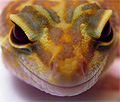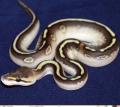» Site Navigation

3 members and 719 guests
Most users ever online was 47,180, 07-16-2025 at 05:30 PM.
» Today's Birthdays

» Stats

Members: 75,912
Threads: 249,118
Posts: 2,572,194
Top Poster: JLC (31,651)
Welcome to our newest member, coda
|
-
Registered User


Re: Bumble Bee X double het caramel glow?
phew...
so this kind of pairing is actually kind of stupid in reality cuz there is no chance of it throwing a visual mutation. SO pretty much in a nutshell there is no way to combine recessive with 2 gene types, and a codom/dom mix and make a visual change right?
BUT!!!
If you took a double het(caramel glow) and bred it to a pastel lesser would that throw a mutation being that it two codom mixed?
-
-
Re: Bumble Bee X double het caramel glow?
 Originally Posted by Turbo Serpent

Everywhere I have read the mutant (recessive) gene is lower case. Because Normal (dominant) is upper case... but as long as you know what you are reading it shouldnt matter I guess.
As I said in my first post "in the examples given", although when I looked back a little bit closer, I see that only Kevin Hornby had stated he was doing it that way. So sorry if that confused you.
I believe "real" scientists used capitol letters for dominant, and lower case for recessive, but it has been a few years so I'm not totally sure.
Be careful with labeling normal as dominant. A normal gene on the albino locus is dominant, but a normal gene on the pinstripe locus is recessive.
And yes, the bottom line is that as long as people know what letters represent what, they should be fine.
-
-
BPnet Veteran


Re: Bumble Bee X double het caramel glow?
 Originally Posted by GenePirate

Bee is on the top, het caramel glow on the bottom. You can set up your square like this:
.........PScg Pscg pScg pscg
psCg
pscg
psCG
pscG
However, don't make things more complicated than they are. The bee has NO chance of throwing a caramel or ghost gene, so take those out of the mix. Similarly, the double het CG has NO chance of contributing a pastel or spider gene, so take those out of the mix. Only consider what your breeders can contribute, then assume the rest. You will wind up with this:
......PS Ps pS ps
Cg
cg
CG
cG
So, you can get equal chances of a bee het for caramel, pastel het for caramel, spider het for caramel, het caramel, bee, pastel, spider, normal, double het CG bee, double het CG pastel, double het CG spider, double het CG, bee het for ghost, pastel het for ghost, spider het for ghost, or het ghost. Each possibility is 1 in 16.
But, you'll have no idea which are going to be the CG single or double hets. Good luck.
 Originally Posted by Kevin_Hornby

I actually find it makes more sense to me if I list all the genes that are involved on both sides.
I agree with Kevin. If you fill out the punnett square:
.........PScg Pscg pScg pscg
psCg
pscg
psCG
pscG
each outcome will show BOTH allels for each gene. If you write it this way:
......PS Ps pS ps
Cg
cg
CG
cG
you only have a single allel for each gene, which isn't an effective way of figuring it out. You won't necessarily know the genotype or phenotype of a given outcome from a cross if you aren't showing both allels. The other way of writing out the punnett square (above) seems much more consistent and relevant.
Another way of thinking about it is to just use what you know. A double het Caramel Glow x normal (since there are no caramel or hypo genes from the other parent) will yield Normals, Het Hypos, Het Caramels, and Double Het Caramel Glow. Since they will all appear normal, they will all be labled as 50% Possible Double Het for Hypo and Caramel (Caramel Glow). A Bee x normal paring will statistically yield 25% Bees, 25% Spiders, 25% Pastels, and 25% Normals. So with a Bee x DH Caramel Glow clutch, just combine the odds. Statistically, you'll get 25% Bees, 25% Spiders, 25% Pastels, and 25% Normals, all of which will be 50% Possible Double Het for Hypo and Caramel (Caramel Glow). Since you can tell the difference between Bees, Spiders, Pastels, and Normals, you'll know what you have when you hatch them out.
Bees 50% Possible Double Het for Hypo and Caramel (Caramel Glow)
Spiders 50% Possible Double Het for Hypo and Caramel (Caramel Glow)
Pastels 50% Possible Double Het for Hypo and Caramel (Caramel Glow)
Normals 50% Possible Double Het for Hypo and Caramel (Caramel Glow)
Just my way of looking at it.
-
-
BPnet Veteran


Re: Bumble Bee X double het caramel glow?
 Originally Posted by kc261

For example, if we are breeding an albino x spider, you would list AAss for the albino, and aaSs for the spider. You can skip pastel, because it doesn't come into play at all. That way the offspring show up as AaSs or Aass rather than AS or As, which could make it look like the albino and spider genes are paired on the same allele, even though they aren't.
.
Be careful; this might confuse people. Each parent can only contribute one allele of the homologous allele pair that they have. So AAss can only contribute As. That's it. aaSs can contribute either aS or as--equal odds. So you will have offspring that are either AaSs or Aass. If that's what you meant, then you hit it.
-
-
Re: Bumble Bee X double het caramel glow?
 Originally Posted by dsmalex97

phew...
so this kind of pairing is actually kind of stupid in reality cuz there is no chance of it throwing a visual mutation. SO pretty much in a nutshell there is no way to combine recessive with 2 gene types, and a codom/dom mix and make a visual change right?
BUT!!!
If you took a double het(caramel glow) and bred it to a pastel lesser would that throw a mutation being that it two codom mixed?
You are right that the pairing would not produce a visual morph (other than pastel, spider, or bumblebee). And neither would double het caramel glow x pastel lesser. That is actually the exact same problem as the first one you proposed (2 codom combo x double het). However, if you take the offspring from either of those pairings, and either pair them together, or back with the double het parent, then you have a chance of getting offspring that are visual for one or both of the recessive traits, as well as one or both of the codom traits. So 1st generation of that pairing might seem "useless", but 2nd generation could produce a 4 gene combo.
-
-
Re: Bumble Bee X double het caramel glow?
 Originally Posted by dsmalex97

phew...
so this kind of pairing is actually kind of stupid in reality cuz there is no chance of it throwing a visual mutation. SO pretty much in a nutshell there is no way to combine recessive with 2 gene types, and a codom/dom mix and make a visual change right?
BUT!!!
If you took a double het(caramel glow) and bred it to a pastel lesser would that throw a mutation being that it two codom mixed?
No matter what, a double het recessive mixed with co-dom will not yield caramel glow, you need to breed 2 double hets or co-doms that also carry the double het in order to have a visual caramel glow.
You could breed a double het CG to a pastel fire yellowbelly lesser spider and it would still yield nothing more than 50% Possible Het Caramel glow 
1.0: Honey Bee | Lesser | Banana Pastel Enchi | Clown 66% Het Albino
0.1: Kingpin | x2 Mojave | Super Pastel HGW | Albino | Sterling Mojave Pinstripe | GHI Pewter | Pastel Het Clown | Sable 66% Het Clown
-
-
Re: Bumble Bee X double het caramel glow?
 Originally Posted by GenePirate

Be careful; this might confuse people. Each parent can only contribute one allele of the homologous allele pair that they have. So AAss can only contribute As. That's it. aaSs can contribute either aS or as--equal odds. So you will have offspring that are either AaSs or Aass. If that's what you meant, then you hit it.
Yeah, sorry, I sort of skipped a step. After you have determined that the albino parent is AAss, you would then write it in the punnett square as passing on As. Then the spider is aaSa, but can pass on either aS or as.
So yes, that's what I meant.
-
 Posting Permissions
Posting Permissions
- You may not post new threads
- You may not post replies
- You may not post attachments
- You may not edit your posts
-
Forum Rules
|








 Reply With Quote
Reply With Quote
